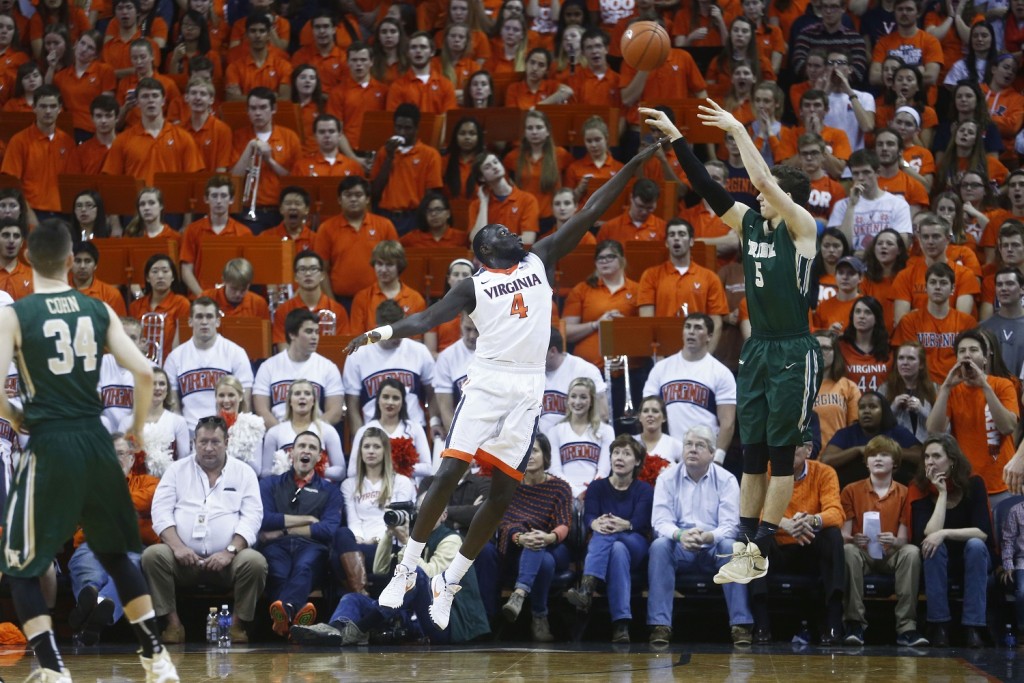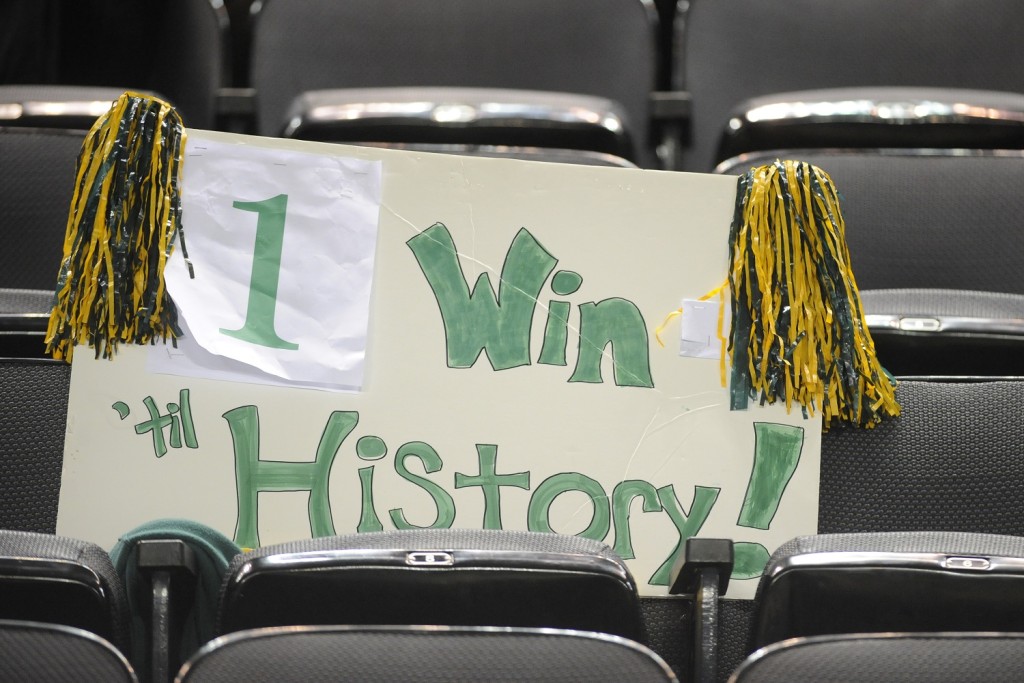WASHINGTON — Many sports fans don’t even begin to pay attention to Division I college basketball until around this time of year, after the Super Bowl. Casual fans may not even begin that process until they start frantically penciling in their brackets in early March. For non-power conference schools, having your name on those brackets may be the only way many people have ever heard of you.
Just ask Valparaiso, or Weber State, or Davidson, or Georgia State. Those schools are etched into March Madness lore after appearing on the stage as unknowns and coming away as storybook tales. But to have a chance to become March’s next Cinderella, you have to make it to the dance first.
William & Mary doesn’t need to be reminded of this.
It’s around this time of year that it is always brought up, the elephant in the gym, the fact that the Tribe are one of just five original Division I teams (along with Army, The Citadel, Northwestern and St. Francis (NY)) never to have made the NCAA Tournament.
“It’s all the NCAA Tournament or not,” says head coach Tony Shaver of the expectations laid on teams like his. “It’s not realistic for most mid-major programs.”
But such pressure is nothing new to Shaver. He played at North Carolina in 1973-74 when NC State handed the Tar Heels their first, second and fourth losses of a 22-6 campaign. Despite being ranked in the top five in the nation much of the season, North Carolina missed the NCAA Tournament, as only the ACC Tournament champion earned a bid back then.
These days, living in conferences like the Colonial Athletic Association (CAA), where William & Mary plays, is something akin to flying in the first few rows of coach in the airplane of Division I ball. It may feel more prestigious than the back of the plane, but the luxuries of first-class — the comfort of extra home games and, crucially, the extra leg room of at-large bids — simply aren’t part of the bargain.
Ken Pomeroy has the Colonial ranked as the ninth-best conference in the country, just below the Atlantic 10 and above the Mountain West. That puts it in into an often heartbreaking middle ground — with just enough good teams to make winning the conference a true accomplishment, but also enough mediocrity to limit it to just the one automatic bid, the same as any other worse conference in the country.
William & Mary is one of four teams ranked in KenPom’s top 100, none of which crack the top 65. The Tribe (17-8, 9-5 CAA) sit in a three-way tie for third in the conference, two and a half games back of UNC Wilmington, to whom they fell on the road in overtime, 97-94, in mid-January. The Tribe will have their opportunity for revenge — and to potentially align themselves for a push toward a regular season conference title — on Thursday, when the Seahawks visit Williamsburg.
But none of that will matter to the selection committee.
Even running the table the rest of the way, finishing 21-8, 13-5 in conference, won’t be enough if William & Mary doesn’t win their conference tournament. Which is a problem the Tribe only know too well.
“It’s definitely the goal for every single one of us,” says leading scorer Omar Prewitt of the Tournament. “We know how good of a team we have and we know we can make there.”
In 2014, the Tribe won 20 games and made it to the CAA final, where they lost by a point to Delaware, 75-74. Last year, they entered the conference tournament as the top seed, survived a double-overtime thriller in the semifinal, but lost again in the final, this time to Northeastern. For the second straight year, the impossible dream remained so, dying on the doorstep.
“It’s not talked about too much,” says Prewitt, but admits he and his teammates dream of being that first team to finally make it. “Every now and then we’ll sit around and say, ‘Wow, what if we’re the team to do it? What will you do after the buzzer goes off?’”
***

The economics of college basketball are tilted toward the rich. Major programs pad their NCAA Tournament resumes by scheduling as many home games as possible, paying smaller schools to make the trip to a hostile environment where they are heavy underdogs. Georgetown, for instance, played eight of its 12 pre-conference games at home, with two neutral court tournament games and a trip to Maryland covering three of the four remaining contests.
In contrast, William & Mary played five of its 11 non-conference games on the road, including three against top-tier competition.
“That’s why 20 wins for a program like ours is a great measuring stick,” says Shaver. “It’s hard to win on the road.”
Just ask Virginia, ranked 7th in the nation despite a losing record on the road (4-5).
Of course, sometimes home court backfires for the giants, like when Monmouth blew out the Hoyas at Verizon Center. Or when William & Mary went into NC State and blasted the Wolfpack by 17 to open their season.
The Tribe also traveled to Dayton and Virginia, two notoriously raucous home courts, dropping a heartbreaker to the Flyers and a blowout to the Cavaliers. And while they’ll almost never be able to convince such teams to come to Williamsburg to play — for reasons both strategic and financial — the Tribe hope to gain valuable experience from their road tests that might help push them over the top in the CAA Tournament.
Both Shaver and senior guard Terry Tarpey agree that the near upset at Dayton was more telling than the win in Raleigh.
“That atmosphere was unlike anything (this year),” says Tarpey, who believes only the game at Wichita State his sophomore year came close in terms of road environment. “When we watched that tape, we learned from it.”
“That’s the most difficult environment we’ve played in all year,” says Shaver. “I remind them from time to time that if we can play in that atmosphere, we can play anywhere in the nation.”
***

The buzz will begin again in Baltimore in a few weeks, as the Tribe will take another shot at history. If they can win three of their final four regular season contests, they will head into the CAA Tournament with 20 victories already in their pocket. That would mark three straight 20-win campaigns, something the school hasn’t seen since 1948-51.
And that’s no small feat to Shaver.
“What I see and feel, and am proud to be a small part of, is that growth,” he says. “I don’t forget that. I was on that sideline in some years when we won three, four, five games.”
He points out that William & Mary has won more conference tournament games than any other team in the CAA since 2008, after winning only two total games before that season.
“Now, we haven’t won (the conference tournament). That’s the only thing anyone wants to write about.”
Tarpey has seen the program grow from just six wins the year before he arrived to now. He and Prewitt both have been instrumental in forging a new path for the program. And whether Tarpey will have the chance to be a part of “that team” or not, he’s proud of the legacy he’ll leave behind upon graduation.
“For me, it’s kind of all relative from freshman year,” he says. “We’ve gotten better every year. That’s all you can kind of focus on, I think. It’s just great to be part of the success, it’s fun.”





